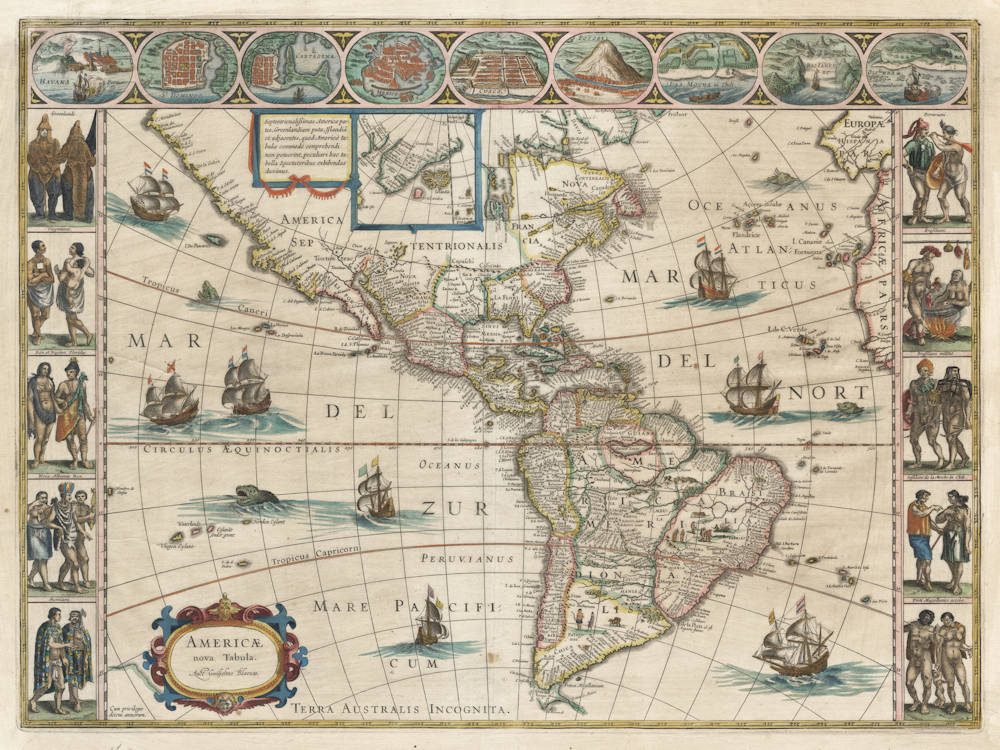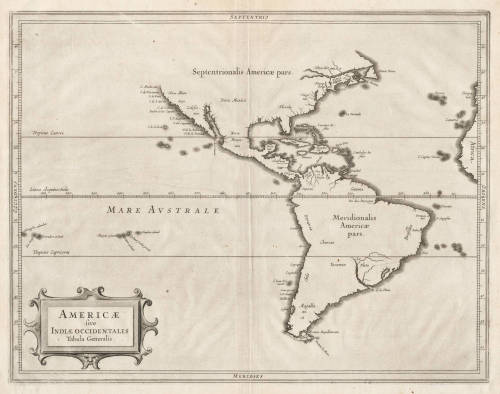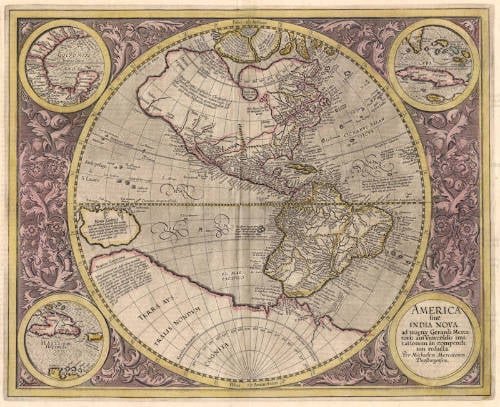Leen Helmink Antique Maps
Antique map of America by Blaeu
Stock number: 18656
Zoom ImageCartographer(s)
Willem Janszoon Blaeu (biography)
Title
Americae nova Tabula Auct. Guiljelmo Blaeuw
First Published
Amsterdam, 1617
This Edition
1642 German
Size
41.0 x 55.5 cms
Technique
Condition
excellent
Price
$ 4,750.00
(Convert price to other currencies)
Description
Willem Janszoon, or Blaeu as he was later to be known, had been issuing separately published maps since 1604. The only atlases he was producing at this time were of the sea. Following the publication of his wall maps of the continents in 1608, one would have expected to see shortly afterwards single sheet versions. However, it was not until 1617 that Blaeu undertook such a project. The date of issue is taken from the Europe in the set.
Similar to the wall map in geography, it does not include many of the cartographical advances made between 1608 and 1617. One of the notable exceptions, however, is the inclusion of Henry Hudson's Bay. The map's popularity rests on its association with arguably the greatest Dutch cartographer of all time. This is one of only a few maps relating to North America by Blaeu. Its visual appeal is enhanced greatly by the inclusion of three decorative borders. The one above contains nine plans or views of towns. The side panels each contain five portraits of figures. These are drawn from various sources, including Theodore de Bry.
In the same year the results of Jacob le Maire and Willem Cornelisz Schouten’s voyage around Cape Horn became known. They showed that Tierra del Fuego was an island and not connected to the unknown southern continent. Owing to law suits that were filed between the Australian Company and the Dutch East India Company, Blaeu was legally barred from incorporating this new information on his maps and globes in July 1617. This restriction was not lifted until August of the following year. Blaeu immediately updated this work to include Fretum le Maire and Statē landt. He also removed the coastline of TERRA AUSTRALIS INCOGNITA east of the title cartouche, mysteriously leaving the name behind. Therefore state 1 of the plate having a life of at most about eighteen months, is extremely rare. Indeed, as late as 1955 only one example was known.
A third state appeared with a revision changing the name to Blaeu in 1621. Keuning wrote in detail about this period of time and the various forms in which we find his name. The change was as a result of the competition of Jan Jansz and the obvious similarities of their names. This state was to appear through to 1630 without text on the reverse. It also appeared in this form in the Atlantis Appendix. This was Blaeu's first attempt at a world atlas, largely instigated by his purchase in 1629 of a number of Jodocus Hondius' plates, and in the following years he would experiment with various formats. In all of these it would appear with text. The author has uncovered two previously unrecorded states with new engraving to the embellishments in the oceans.
(Burden)
The New World. Originally issued by Willem Blaeu as early as 1617, this general map of the Americas was one of the longest-lived plates in the atlas, having been used as an atlas map since 1630.
Here is the general seventeenth-century European view of the Western Hemisphere: the delineation of the coast and the nomenclature of the Pacific as well as the Atlantic coasts are basically Spanish in origin and follow the maps of the Fleming Abraham Ortelius and his countryman Cornelis Wytfliet. To These, Willem Blaeu inserted, on the east coast, the English names given by the Roanoke colonists in Virginia and by Martin Frobisher, John Davis and Henry Hudson in the far north. In Florida and along the St Lawrence, Blaeu added the names given by the French settlers, almost the only memorials of their ill-fated venture in Florida during the latter part of the sixteenth century.
When Blaeu first made his map in the early years of the seventeenth century, Europeans still had no real knowledge of the nature of the Mississippi system. From the expedition journals of Hernando de Soto (1539-1543), they had inferred an extensive range of mountains trending east-west to the north of the coast of the Gulf of Mexico in 'la Florida', apparantly precluding a great river system.
The Great Lakes were, as yet, unknown, although by the time Blaeu issued this map in its atlas form in the 1630s, Samuel de Champlain's travels in the Huron region together with his hearsay accounts from Coral Indians were becoming well-known through his 1632 map of the region. Evidently, this appears to have been unknown to Blaeu at the time, but surprisingly, he never incorporated the information on later printings of the map! The same applies to Manhattan and Long Island as well, despite the fact that only a small distance from Amsterdam, the Leiden academic Johannes de Laet had published the first edition of his monumental work on the Americas which provided source materials for any number of maps of the Americas throughout the remainder of the century and beyond.
In common with the other general continental maps in the atlas, Blaeu has provided perspective plans or views of settlements in the Americas, including Havana, St Domingo, Cartagena, Mexico, Cusco, Potosi, I. la Mocha in Chile, Rio Janeiro and Olinda in Pernambuco, as well as the vignette illustrations of native figures taken from the accounts of John White (Virginia) or Hans Staden (Brazil) and others.
(Goss)
Blaeu's maps set the standard for the carte á figures style. Of all world and continents sets, Blaeu's stands out as the finest in quality, both in aesthetics and relative geographical accuracy. To a very large extent, the Dutch Golden Age of Cartography was epitomized in the maps of Willem Blaeu.
Praise of these maps has not been restrained. The world map has been acclaimed as "one of the supreme examples of the map maker's art" (Shirley). Goss hails the Americas map, saying "this magnificent map sums up the general European view of the Western Hemisphere in the early seventeenth century."
Well after the rest of the mapmaking community had accepted the California-as-an-island canard, Blaeu's maps stubbornly insist on California's true, peninsular nature.
(Martayan Lan)
Willem Janszoon Blaeu (1571-1638)
Joan Blaeu (son) (1596-1673)
Cornelis Blaeu (son) (?-c.1642)
Willem Jansz. [Blaeu] and his son Joan are the most widely known cartographic publishers of the seventeenth century. Born as the son of a wealthy herring merchant in Alkmaar North Holland, to Anna, a first cousin of Willem. Cornelis Hooft was merchant in oil, grain and herring and twelve times mayor of Amsterdam. He hoped that Willem would take over his business.
But Willem was more interested in mathematics, astronomy and other scientific matters, however, and in 1595 he left for Denmark to study with the astronomer Tycho Brahe on the island of Ven. Brahe had established here his own observatory as well as a workshop for the manufacturing of instruments and a printing office. This enabled young Willem to acquire both theoretical and practical knowledge and provided him with contacts among like-minded people. After his return to the Netherlands he applied himself to astronomy for several years in his native Alkmaar. Here he published his first cartographic work: a celestial globe according to the observations of Tycho Brahe.
At the end of the sixteenth century Willem Jansz. moved with his family to Amsterdam. He set up a shop in celestial and terrestrial globes and nautical instruments, since the rapid growth of seafaring opened a large market for these goods. Soon he was able to offer for sale globes in various sizes. In 1605 Willem Jansz. moved to a new location at the "Op ‘t Water" (today Damrak nr. 46), a house with the sign of in de Vergulde Sonnewijwyser ("in the Gilded Sundial"). Apart from the manufacturing globes, Willem Jansz. published numerous maps and charts in folio size, along with multi-sheet wall maps, town views, and historical prints, all of which are now very rare.
Willem Jansz. made an unmatched contribution to the fields of navigation and cartography. His "Het Licht der Zee-vaert", published in 1608, was of great consequence for navigation in European coastal waters. He used the same oblong-size like Waghenaer did in his "Thresoor der Zeevaert" (1592): the work was constructed in a series of chapters, adding to each chapter sailing-descriptions for a specific stretch of coast and the corresponding chart. The coastal profiles in woodcut have been included in the text of each chapter.
In 1618 another mapmaker, bookseller and publisher, Jan Jansz. (Joannes Janssonius) established himself on the Damrak next door to Willem Jansz.’s shop. Accusing each other of copying and stealing information, the neighbours became fierce competitors. In about 1621, Willem Jansz. decided to put an end to the confusion between his name and his competitor’s and assumed his grandfather’s sobriquet, (Blauwe Willem), as the family name; thereafter he called himself Willem Jansz. Blaeu.
Responding to Janssonius’s plagiarism of "Het Licht der Zeevaert", Blaeu published a new pilot-guide in 1623: the "Zeespiegel", a description of the seas and coasts of the Eastern, Northern and Western Navigation. Approximately the same coastal areas are described as in the older "Het Licht der Zeevaert", but in a much more elaborate way and with a far greater number of charts.
Apart from pilot-guides, Blaeu also published single-sheet charts, often printed on durable vellum. As example attention is here given to the so-called "West-Indische Paskaert", a chart of the Atlantic Ocean in Mercator’s projection, published about 1630. Despite the obvious advantages for navigation, the charts drawn on this projection were only gradually accepted by navigators.
Blaeu was nearing the age of sixty when in 1630 he published his first atlas of the world and began to compete with Henricus Hondius. For many years Blaeu toyed with the idea of publishing his own atlas of the world. The initial material for an atlas was in Blaeu’s hands in the form of his own folio-maps, which he had begun publishing in 1604. Blaeu’s plan gained momentum, however, when he succeeded in 1629 in purchasing a large number of copperplates that had belonged to the late Jodocus Hondius the younger. Blaeu quickly amended these plates by replacing Hondius’s name with his own imprint, a common procedure in those days. In 1630 Blaeu published the "Atlantis Appendix", using his own maps and the amended maps of Jodocus Hondius. The world atlas consists of 60 maps, but without a descriptive text. In 1631 a new world atlas was published , titled "Appendix Theatri A. Ortelii et Atlantis G. Mercatoris", provided with a Latin text and nearly hundred maps. The intention in publishing this atlas was to produce a supplement to the works of the two famous geographers. Henricus Hondius and his brother-in-law Joannes Janssonius immediately took steps in reaction to the publication of Blaeu’s "Appendix" and published amended atlas-publications.
The fierce competition between Blaeu and Hondius-Janssonius greatly influenced the further development of their atlas productions. Blaeu now intended to distance himself completely from Ortelius and Mercator and to publish an entirely new world atlas in four languages. In 1634 a German edition was published, which contains a number of unfinished maps, a sign that the work was done hurriedly in order to have the atlas published in time.
The extent of Blaeu’s ambitious plans for the world atlas is reflected in his preface, where he states that it is his intention to describe the whole world and to depict all the ports and seas, and therefore several other volumes of the atlas were to follow shortly. In view of these plans, Blaeu’s investment in a new printing shop in 1637 is not surprising. Yet Blaeu did not live to see the publication of a new volume. After his death the business was continued by his two sons Joan and Cornelis, the elder of whom had been collaborating on the atlas since 1631. In 1640 a third volume was published (Italy), in 1645 a fourth (England and Wales), in 1654 a fifth (Scotland) and finally in 1655, a sixth volume covered China.
In addition to his activities as publisher, Willem Jansz. Blaeu continued his scientific pursuits. His expertise won official recognition at his appointment as chart maker and examiner of navigating officers by the Amsterdam Chamber of the United Dutch East India Company (VOC).
Blaeu’s new position gave him access to the enormous map archives of the VOC. He performed the function of chart maker until his death in 1638. For his task he employed the four assistants of his deceased predecessor Hessel Gerritsz. Blaeus’s work was most probably limited – given his age – to the supervision of his employees in the manufacture of charts, to the supervision of content and to any alterations and improvements required. A steady stream of charts, required to equip the ships, must have left his workshop. Thanks to his position as chart maker of the VOC, Blaeu was able to expand his world atlas of Asia with new maps and gain the edge on his Amsterdam competitors, Hondius and Janssonius.
Willem Jansz. Blaeu died in October 1638, leaving his prospering business to his sons, Joan and Cornelis.
(Schilder)






